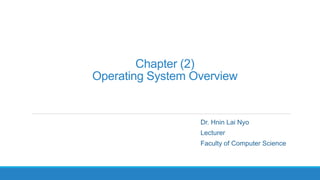
Ch2_OS_Lecture 3.pptx
- 1. Chapter (2) Operating System Overview Dr. Hnin Lai Nyo Lecturer Faculty of Computer Science
- 2. Lecture Contents Lecture 1: Operating System Objectives and Functions Lecture 2: The Evolution of Operating System Lecture 3: Major Achievements Lecture 4: Developments Leading to Modern Operating Systems FACULTY OF COMPUTER SCIENCE, UNIVERSITY OF COMPUTER STUDIES
- 3. Lecture 3: Major Achievements FACULTY OF COMPUTER SCIENCE, UNIVERSITY OF COMPUTER STUDIES The Process Memory Management Information Protection and Security Scheduling and Resource Management
- 4. Learning Objectives FACULTY OF COMPUTER SCIENCE, UNIVERSITY OF COMPUTER STUDIES To know the major achievements in operating system To understand process management, memory management, information protection and security, scheduling and resoruce management
- 5. FACULTY OF COMPUTER SCIENCE, UNIVERSITY OF COMPUTER STUDIES Four major theoretical advance in the development of OS: Processes Memory management Information protection and security Scheduling and resource management Major Achievements in Operating Systems
- 6. FACULTY OF COMPUTER SCIENCE, UNIVERSITY OF COMPUTER STUDIES Processes A program in execution An instance of a program running on a computer The entity that can be assigned to and executed on a processor A unit of activity characterized by a single sequential thread of execution, a curent state, and an assiciated set of system resources.
- 7. FACULTY OF COMPUTER SCIENCE, UNIVERSITY OF COMPUTER STUDIES Processes Development of the Process Three major lines of computer system development created problems in timing and synchronization that contributed to the development: Multiprogramming Batch Operation Processor is switched among the various programs residing in main memory Time Sharing It is responsive to the individual user but be able to support many users simultaneously. Real-time Transaction Systems A number of users are entering queries or updates against a database.
- 8. FACULTY OF COMPUTER SCIENCE, UNIVERSITY OF COMPUTER STUDIES Processes Processes Management i Context Data Program (code) Context Data Program (code) i j Process list Process A Process B b h Process index PC b h Base limit . . . Other registers Main memory Processor registers Figure 2.8 Typical Process Implementation
- 9. FACULTY OF COMPUTER SCIENCE, UNIVERSITY OF COMPUTER STUDIES Memory Management The OS has five principle storage management responsibilities: Process isolation Automatic allocation and management Support of modular programming Protection and access control Long-term storage
- 10. FACULTY OF COMPUTER SCIENCE, UNIVERSITY OF COMPUTER STUDIES Memory Management A facility that allows programs to address memory from a logical point of view, without regard to the amount of main memory physically available. Conceived to meet the requirement of having multiple user jobs reside in main memory concurrently. Allow processes to be comprised of a number of fixed size blocks, called pages. Program references a word by means of a virtual address (page no. + offset) Provides for a dynamic mapping between the virtual address used in the program and a real address in main memory. Virtual Memory Paging
- 11. FACULTY OF COMPUTER SCIENCE, UNIVERSITY OF COMPUTER STUDIES Memory Management A1 A0 A2 A5 B0 B1 B2 B3 A7 A9 A8 B5 B6 Main memory User program A User program B Disk Main memory consists of a number of fixed-length frames, each equal to the size of a page. For a program to execute, some or all of its pages must be in main memory. Secondary memory (Disk) can hold many fixed-length pages. A user program consists of some number of pages. Pages for all programs plus the OS are on disk, as are files. Figure 2.9 Virtual Memory Concepts 0 1 2 3 4 5 6 7 8 9 0 1 2 3 4 5 6
- 12. FACULTY OF COMPUTER SCIENCE, UNIVERSITY OF COMPUTER STUDIES Memory Management Figure 2.10 Virtual Memory Addressing Virtual address Processor Memory management unit Main memory Secondary memory Real address Disk address
- 13. FACULTY OF COMPUTER SCIENCE, UNIVERSITY OF COMPUTER STUDIES Memory Management Information Protection and Securtiy The nature of the threat that concerns an organization will vary greatly depending on the circumstances. The problem involves controlling access to computer systems and the information stored in them. Much of the work in security and protection as it relates to OS can be roughly groupted into four categories: Availability : protecting the system against interruption Confidentiality : Assures that the unauthorized users cannot read/access data Data integrity : Protection of data from unauthorized modification. Authenticity : the proper verfication of the identity of users and the validty of messages or data.
- 14. FACULTY OF COMPUTER SCIENCE, UNIVERSITY OF COMPUTER STUDIES Memory Management Scheduling and Resource Management A key responsibility of an OS is managing resources. Any resource allocation and schedulig policy must consider three factors: All processes that are competing for the use of a particular resource to be equal and fair access. Fairness To discriminate among different classes of jobs with different service requirements. To make allocation and scheduling decisions to meet the total set of requirements Differential responsiveness The OS should attempt to maximize throughput, minimize response time and accomodate as many users as possible. Efficiency
- 15. FACULTY OF COMPUTER SCIENCE, UNIVERSITY OF COMPUTER STUDIES Summary In this lecture, you learned about Three major lines of computer system development created problems in timing and synchronization that contributed to the development. Five principal storage management responsibilities. Security and protection as it related to OS. Resource allocation and scheduling policy.
- 16. Learning Outcomes FACULTY OF COMPUTER SCIENCE, UNIVERSITY OF COMPUTER STUDIES After the end of the lecture, the students will be able to: know the major theoretical advance in the development of operating system. Understand memory management and resource allocation policies.
- 17. References FACULTY OF COMPUTER SCIENCE, UNIVERSITY OF COMPUTER STUDIES 1. “Operating Systems, internal and Design Principles” by William Stallings, 7th Edition, ISBN 13: 978-13-230998-1.